Christianity in Turkey
 From Wikipedia - Reading time: 52 min
From Wikipedia - Reading time: 52 min
| Total population | |
|---|---|
| Est. 203,500–370,000+[1][2][3][4] | |
| Religions | |
| Christianity (Catholic Church, Eastern Orthodox Church, Oriental Orthodoxy, Protestantism) | |
| Languages | |
| Arabic, Armenian, Bulgarian, Ecclesiastical Latin, English, Georgian, Greek (Liturgical), Korean, Persian, Russian, Syriac, Turkish, Ukrainian |
| Christianity by country |
|---|
 |
|
|
Religion in Turkey  |
|---|
| Secularism in Turkey |
| Irreligion in Turkey |

Christianity in Turkey has a long history, dating back to the early origins of Christianity in Asia Minor and the Middle East during the 1st century AD.[3] In modern times the percentage of Christians in Turkey has declined from 20-25% in 1914, to about 2% in 1927, to 0.2–0.4% today[5][6][7][8] Sources estimate that the Christian population in Turkey ranges between 203,500 and more than 370,000.[1][3][4][9] However, the exact number remains unclear due to the absence of a religious census in the country.[10] The percentage of Christians in Turkey fell mainly as a result of the late Ottoman genocides:[19] the Armenian genocide, Greek genocide, and Assyrian genocide,[20] the population exchange between Greece and Turkey,[11][17][21] the emigration of Christians that began in the late 19th century and gained pace in the first quarter of the 20th century,[17][22] and due to events such as the 1942 Varlık Vergisi tax levied on non-Muslim citizens in Turkey and the 1955 Istanbul pogrom against Greek and Armenian Christians.[17] Exact numbers are difficult to estimate,[10][23] as many Turkish former Muslim converts to Christianity often hide their Christian faith for fear of familial pressure, religious discrimination, and persecution.[11][24][25][26]
This was due to events which had a significant impact on the country's demographic structure, such as the First World War,[27] the anti-Christian genocides of Greeks, Armenians, and Assyrians perpetrated by Turkish Muslims,[28] and the population exchange between Greece and Turkey,[11][29] and the emigration of persecuted Christians (such as Assyrians, Greeks, Armenians, etc.) to foreign countries (mostly in Europe and the Americas) that began in the late 19th century and gained pace in the first quarter of the 20th century, especially during World War I.[17][18][30] Signed after the First World War, the Treaty of Lausanne explicitly guarantees the security and protection of both Greek and Armenian Orthodox Christian minorities. Their religious institutions are recognized officially by the Republic of Turkey.[31][32]
In 2011 according to the Pew Research Center, there were more than 200,000-320,000 people of different Christian denominations in Turkey,[33] representing roughly 0.3-0.4 percent of Turkey's population,[5] including an estimated 80,000 population of Oriental Orthodox Christians,[34] 47,000 Turkish Orthodox Christians,[35][36] 35,000 Roman Catholic Christians,[37] 18,000 Antiochian Greeks,[38] 5,000 Greek Orthodox Christians,[34] 8,000 Protestant Christians, 4,994 Jehovah's Witnesses,[39] and 512 Mormons.[40] There is also a small group of ethnic Orthodox-Christian Turks (mostly living in Istanbul and İzmir) who follow the Greek Orthodox, Turkish Orthodox, or Syriac Orthodox churches, and additionally Protestant Turks who still face difficulties regarding social acceptance, and also historic claims to churches or property in the country because they are former Muslim converts to Christianity from Turkish–Muslim background, rather than ethnic minorities.[24] Ethnically Turkish Protestants number around 7,000–8,000.[41][42] In 2009, there were 236 Christian churches open for worship in Turkey.[43] The Eastern Orthodox Church has been headquartered in Constantinople since the 4th century AD.[44][45][24]
In 2020 the Anadolu Agency, a state-run news agency of the Turkish government, claimed that the number of Christians in Turkey was 180,854, which corresponds to 0.2% of the population.[46] In a 2022 report of the U.S. Department of State, Christians were seen as being 0.2% of the population.[47] The estimated number of adherents mainly refers to Armenian Orthodox Christians, Armenian Catholics, Chaldean Catholics, Eastern Catholics, Greek Orthodox Christians, Oriental Orthodox Christians, Protestants, and Syriac Orthodox Christians, as well as smaller groups.[47] It was noted that the number of Eastern Orthodox Christians had risen sharply, mainly due to refugees from Russia and Ukraine.[47] In 2024, Freedom House rated the country 2 out of 4 for religious freedom; this was mainly due to disputes over land.[48] The Mor Ephrem Syriac Orthodox church, opened in October 2023, was the first church built since the foundation of the Republic of Turkey.[49]
Historical background
[edit]Early Christianity
[edit]



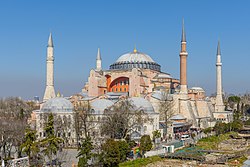
The Christianization of ancient Assyrians and Armenians most likely began around the 1st century AD.[3] The spread of Christianity beyond Jerusalem is discussed in the Book of Acts.[50]
The Cappadocian Fathers produced some of the earliest hagiographies in the region. In addition to writings about feminine virtue by Gregory of Nyssa and Gregory of Nazianzos; later texts about Nicholas of Sion and Theodore of Sykeon described miracles and rural life.[51]
The historical region of Syria became one of the main centers of miaphisite Christianity, embodied in the Oriental Orthodoxy, which had accepted only the first three ecumenical councils: Nicaea (325), Constantinople (381) and Ephesus (431). Miaphisite Christians were strongly opposed to Chalcedonian Creed that had been established by the Council of Chalcedon in 451. In the 5th and 6th centuries, the Syriac Orthodox Church that originated in Antioch continued to fracture into multiple denominations.[52] Some Armenian miaphysite Christians sought to reunite with Rome in later centuries, but their efforts were unsuccessful.[50]
Constantinople is generally considered to be the center and the "cradle of Orthodox Christian civilization".[53][54] From the mid-5th century to the early 13th century, Constantinople was the largest and wealthiest city in Europe.[55] The city became famous for its architectural masterpieces, such as Hagia Sophia, the cathedral of the Eastern Orthodox Church, which served as the seat of the Ecumenical Patriarchate, the sacred Imperial Palace where the Emperors lived, the Hippodrome, the Golden Gate of the Land Walls, and opulent aristocratic palaces. The University of Constantinople was founded in the fifth century and contained artistic and literary treasures before it was sacked in 1204 and 1453,[56] including its vast Imperial Library which contained the remnants of the Library of Alexandria and had 100,000 volumes.[57] The city was the home of the Ecumenical Patriarch of Constantinople and guardian of Christendom's holiest relics such as the Crown of thorns and the True Cross. During most of its existence, the Byzantine Empire was one of the most powerful economic, cultural, and military forces in Europe.[58] The imperial role in the affairs of the Church never developed into a fixed, legally defined system.[59] Additionally, due to the decline of Rome and internal dissension in the other Eastern Patriarchates, the Church of Constantinople became, between the 6th and 11th centuries, the richest and most influential centre of Christendom.[60]
The Eastern Orthodox Church split from Rome during the Great Schism of 1054. With the arrival of the crusaders many Orthodox bishops, particularly in Antioch, were replaced by Latin prelates. After the Mongols defeated the Abbasid Caliphate in 1258, the Armenians and Nestorians had decent relations with the conquering Il-khans for a time, but by the end of the 14th-century many Syrian Orthodox and Nestorian churches were destroyed when the Turco-Mongolian ruler Temür raided West Asia.[50]
Two out of the five centers (Patriarchates) of the ancient Pentarchy are in Turkey: Constantinople (Istanbul) and Antioch (Antakya). Antioch was also the place where the followers of Jesus were called "Christians" for the first time in history, as well as being the site of one of the earliest and oldest surviving churches, established by Saint Peter himself. For a thousand years, the Hagia Sophia was the largest church in the world.
Turkey is also home to the Seven Churches of Asia, where the Revelation to John was sent. Apostle John is reputed to have taken Virgin Mary to Ephesus in western Turkey, where she spent the last days of her life in a small house, known as the House of the Virgin Mary, which still survives today and has been recognized as a holy site for pilgrimage by the Catholic and Orthodox churches, as well as being a Muslim shrine. The cave of the Seven Sleepers is also located in Ephesus.
The death of the Forty Martyrs of Sebaste (modern day Sivas) is recorded as 320 AD during a persecution by Emperor Licinius. They are mentioned by Basil, Gregory of Nyssa, Ephrem the Syrian and John Chrysostom.[61]
Ottoman Empire
[edit]

In accordance with the traditional custom of the time, the Ottoman sultan Mehmed II allowed his troops and his entourage three full days of unbridled pillage and looting in the Christian city of Constantinople, capital of the Roman Empire since its foundation by the Roman Emperor Constantine the Great in the 4th century AD, shortly after it was captured in 1453. Once the three days passed, he would then claim its remaining contents for himself.[62][63] However, by the end of the first day, he proclaimed that the looting should cease as he felt profound sadness when he toured the looted and enslaved city.[64][62] The cathedral of Hagia Sophia was not exempted from the pillage and looting and specifically became its focal point, as the Ottoman Turks believed it to contain the greatest treasures and valuables of the city.[65] Shortly after the defence of the Walls of Constantinople, the city collapsed and the Ottoman troops entered victoriously; the pillagers and looters made their way to the Hagia Sophia and battered down its doors before storming in.[66]
Throughout the period of the siege of Constantinople, the trapped Christian worshippers of the city participated in the Divine Liturgy and the Prayer of the Hours at the Hagia Sophia and the church formed a safe-haven and a refuge for many of those who were unable to contribute to the city's defence, which comprised women, children, elderly, the sick, and the wounded.[67][68] Being trapped in the church, the many congregants and yet more refugees inside became spoils-of-war to be divided amongst the Ottoman invaders. The building was desecrated and looted, with the helpless occupants who sought shelter within the church being enslaved.[65] While most of the elderly, the infirm/wounded, and sick were killed, and the remainder (mainly teenage males and young boys) were chained up and sold into slavery.[66]
The women of Constantinople also suffered from rape and sexual violence at the hands of Ottoman forces.[69] According to historian Barbaro, "all through the day the Turks made a great slaughter of Christians through the city". According to historian Philip Mansel, widespread persecution of the city's civilian inhabitants took place, resulting in thousands of murders and rapes, and 30,000 civilians being enslaved or forcibly deported.[70][71][72][73] George Sphrantzes says that people of both sexes were raped inside the church of Hagia Sophia.

The first capitulation concluded between the Ottoman Empire and a foreign state was that of 1535, granted to the Kingdom of France.[74] The Ottoman Empire was then at the height its power, and the French king Francis I had shortly before sustained a disastrous defeat at the Battle of Pavia. His only hope of assistance lay in the Ottoman sultan Suleiman I. The appeal to Suleiman on the ground of the common interest of the Kingdom of France and the Ottoman Empire in overcoming the power of the Holy Roman Emperor Charles V overweening power was successful; thus was established the Franco-Ottoman alliance, and in 1536 the capitulations were signed.[74] They amounted to a treaty of commerce and a treaty allowing the establishment of Christian Frenchmen in Ottoman Turkey and fixing the jurisdiction to be exercised over them: individual and religious liberty was guaranteed to them, the King of France was empowered to appoint consuls in Ottoman Turkey, the consuls were recognized as competent to judge the civil and criminal affairs of French subjects in Ottoman Turkey according to French law, and the consuls may appeal to the officers of the sultan for their aid in the execution of their sentences.[74] This, the first of the capitulations, can be seen as the prototype of its successors.[74]
Anglican, American Presbyterian, and German Lutheran missionaries arrived in the Ottoman Empire in the 19th century.[50] During the same period, there were nationalistic campaigns against Assyrians which often had the assistance of Kurdish paramilitary support. In 1915, Turks and Kurds massacred tens of thousands Assyrians in Siirt. Assyrians were attacked in the Hakkari mountains by the Turkish army with the help of Kurdish tribes, and many Christians were deported and about a quarter million Assyrians were murdered or died due to persecution. This number doubles if the killings during the 1890s are included.[75] Kurds saw the Assyrians as dangerous foreigners and enforcers of the British colonizers, which made it justifiable to them to commit ethnic cleansing. The Kurds fought the Assyrians also due to fears that the Armenians, or European colonial powers backing them, would assume control in Anatolia.[76] Kurdish military plundered Armenian and other Christian villages.[76]
In the 1890s the Hamidiye (Kurdish paramilitary units) attacked Armenians in a series of clashes that culminated in the Hamidian massacres of 1894-1896 and the Adana massacre in 1909. It is estimated that between 80,000 and 300,000 Armenians were killed during these pre-War massacres.[3][77][78][79] Into the 19th century, the Christians of Istanbul tended to be either Greek Orthodox, members of the Armenian Apostolic Church or Catholic Levantines.[80]
First World War
[edit]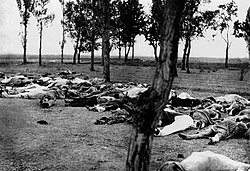

During the tumultuous period of the First World War, up to 3 million indigenous Christians are alleged to have been killed. Prior to this time, the Christian population stood at around 20% -25% of the total. According to professor Martin van Bruinessen, relations between Christians and Kurdish and other Muslim peoples were often bitter and during World War I "Christians of Tur Abdin (in Turkey) for instance have been subjected to brutal treatment by Kurdish tribes, who took their land and even their daughters".[83]
Kurdish-dominated Hamidiye slaughtered Christian Armenians in Tur Abdin region in 1915.[84] It is estimated that ten thousand Assyrians were killed, and reportedly "the skulls of small children were smashed with rocks, the bodies of girls and women who resisted rape were chopped into pieces live, men were mostly beheaded, and the clergy skinned or burnt alive...."[84] In 1915, Turks and Kurds plundered the Assyrian village of Mar-Zaya in Jelu and slaughtered the population, it is estimated that 7,000 Assyrians were slaughtered during this period. In September 1914 more than 30 Armenian and Assyrian villages were burnt by Kurdish and Turkish mobs in the Urmia region.[84] After the Russian army retreated, Turkish troops with Kurdish detachments organized mass slaughters of Assyrians, in the Assyrian village of Haftvan 750 men were beheaded and 5,000 Assyrian women were taken to Kurdish harems.[84] Turks and Kurds also slaughtered Christians in Diarbekir. There was a policy during the Hamidian era to use Kurdish tribes as irregulars (Hamidiye units) against the Armenians.[84][85][86][87]
Treaty of Lausanne
[edit]The Greek forces who occupied Smyrna in the post-war period were defeated in the Turkish War of Independence which ended with the signing of the Treaty of Lausanne. Under the terms of the peace treaty, 1.3 million Christian residents of Turkey were relocated to Greece and around 400,000 Muslims were likewise moved from Greece to Turkey. When the Turkish state was founded in 1923 the remaining Greek population was estimated to be around 111,000; the Greek Orthodox communities in Istanbul, Gökçeada, and Bozcaada numbering 270,000 were exempted. Other terms of the treaty included various provisions to protect the rights of religious minorities and a concession by the Turks to allow the Greek Orthodox Patriarchate to remain in Istanbul.[88]
Republic of Turkey (1923–present)
[edit]
The British Broadcasting Corporation (BBC) reported in 2014 that the Christian population of Turkey had declined from 20% to 0.2% since 1914.[89]
The U.S. Commission on International Religious Freedom (USCIRF) designated Turkey a "Country of Particular Concern" for religious freedom, noting "systematic limitations on the freedom of religion or belief" with respect to access to places of worship, religious education, and right to train clergy. The report does note some areas of improvement such as better protection of the property rights of Non-Muslims.[90]
In the pre-war period, Protestant Christian missionaries from North America had been actively involved in the Ottoman education system. Many of the schools were closed down and suffered under stringent regulations and burdensome taxes during the secularization of Turkey. Historically, these schools had worked with the Christian communities in the Ottoman Empire, and were regarded with suspicion by the fledgling republic.[91]
In 2001, Turkey's National Security Council (MGK) reported that it considers Protestant Christian missionaries the third largest threat to Turkey's national security, surpassed only by Islamic fundamentalism and the Kurdish separatist organization Kurdistan Workers' Party (PKK). A 2004 report by the Turkish Armed Forces (TAF) similarly recommended implementing new laws to curb Christian missionary activities in the country. According to the Turkish Evangelical Churches movement, Turkish Protestant churches had only 3,000 members in 2009—about half of these were former Muslim converts to Christianity, while the others were Christian converts from Armenian Orthodox and Syriac Christian churches.[92] Since Turkish nationality was often perceived exclusively as a Muslim identity after the Balkan Wars, the influence of Protestant Christian missionaries on Turkey's Alevi population has been a concern since the era of Committee of Union and Progress rule.[92][93] In 2016, the Association of Protestant Churches in Turkey released a report warning of an increase in anti-Christian hate speech.[94]
Historically, the Christian population of Turkey has been largely peaceful and non-disruptive, with the notable exception of one former Muslim convert to Christianity who hijacked the Turkish Airlines Flight 1476 in 2006 with the stated intent of flying it to the Vatican to meet the Pope and ask for his help to avoid serving in the Turkish Armed Forces, which he referred to as a "Muslim army".[95]
In 2013, the Washington Post reported that members of the ruling Justice and Development Party had expressed their desires to convert Hagia Sophia into a mosque. Hagia Sophia, which is called ayasofya in Turkish, is an ancient Christian church dating to 360 AD that was converted into a mosque after Mehmed II invaded Constantinople in 1453. It has been a museum since 1935. Patriarch Bartholomew objected to the government's rhetoric, saying "If it is to reopen as a house of worship, then it should open as a Christian church."[96] Also in 2013, the government announced that the 5th-century Monastery of Stoudios, located in Istanbul's Samatya neighborhood, would be converted into a mosque. The monastery, one of Byzantium's most important, was sacked during the Crusades and later served as a mosque for a time, until it was converted to a museum during the 20th century.[97][98][99]
Today, the Christian population of Turkey is estimated at 203,500–370,000 Christians.[2][3][4][34][100] 35,000 Catholics of varying ethnicities, 25,000 ethnic "Assyrians" (Turkish: Süryaniler), (mostly followers of the Syriac Orthodox Church, Syriac Catholic Church, the Church of the East, and the Chaldean Catholic Church),[101] 3,000–4,000 Greek Orthodox,[100] 15,000–18,000 Antiochian Greeks[102] and smaller numbers of Bulgarians, Georgians, and Protestant Christians of various ethnicities. Moreover, there is an ethnic Turkish Protestant Christian community in Turkey which number about 7,000–8,000 adherents;[42][41] most of these Christian converts are from Turkish–Muslim background.[103][104][105] In 2003, the mainstream Turkish newspaper Milliyet reported that 35,000 Turkish former Muslims had converted to Christianity.[23] According to Bekir Bozdağ, Deputy Prime Minister of Turkey, there were 349 active churches in Turkey in October 2012: 140 Greek, 58 Assyrian, and 52 Armenian.[106] In 2015, the Turkish government gave permission for the Christian channel SAT-7 to broadcast on the government-regulated Türksat satellite.[107]
Since the establishment of the modern Republic of Turkey in 1923, a number of high-profile incidents targeting Non-Muslims, including Christians, have occurred.[3] This includes the Istanbul pogrom of 1955, where non-Muslims were attacked and killed, as well as more recent attacks, such as the assassination of prominent Turkish–Armenian journalist Hrant Dink in 2007, the torture and murder of one German Protestant and two Turkish converts to Christianity in what Turkish media dubbed "the missionary massacres" in the same year,[108][109] and the killings of Italian Catholic priests, including Andrea Santoro, in 2006 and 2007. In January 2024, two gunmen fatally shot a man during a church service in Istanbul in an attack claimed by the Islamic State (Daesh).[110]
Christian communities
[edit]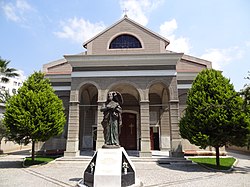
The largest Christian population in Turkey is located in Istanbul, which has a large community of Armenians and Greeks. Istanbul is also where the Patriarchate of Greek Orthodox Christianity is located. Antioch, located in Turkey's Hatay province, is the original seat of the namesake Antiochian Orthodox Church, but is now the titular see. The area, known for having ethnic diversity and large Christian community, has 7,000 Christians and 14 active churches. The city has one of the oldest churches in the world as well, called the Church of St Peter, which is said to have been founded by the Saint himself.[111]
The Syriac Orthodox Church has a strong presence in Mardin; many Assyrian Christians left during the late Ottoman genocides in 1915.[112] Tur Abdin is a large area with a multitude of mostly Syriac Orthodox churches, monasteries, and ruins. Settlements in Tur Abdin include Midyat. The Christian community in Midyat is supplemented by a refugee community from Syria and has four operating churches.[113] Some of the most significant Syriac churches and monasteries in existence are in or near Midyat including Mor Gabriel Monastery and the Saffron Monastery.
By the 21st century, Greek Orthodox Christians in Turkey had declined to only around 2,000–3,000.[88] There are between 40,000 and 70,000 Armenian Orthodox Christians in Turkey.[3] By some estimates, in the early 2000s there were between 10,000 and 20,000 Catholics and Protestants in Turkey.[114] Since the 1960s, a growing number of Turkish former Muslims are converting to Christianity;[23] estimates range from 4,000 to 35,000 by various sources.[23][115][116][117]
Martin Kmetec, a Conventual Franciscan friar and current Archbishop of İzmir, stated in an interview with Aid to the Church in Need that ecumenical relations between Christians are generally good in the country: "In general, our relations with other Christian churches are good. The Ecumenical Patriarch of Constantinople, Bartholomew I, for example, has a good relationship with the Focolare Movement and the new Apostolic Vicar of Istanbul, Bishop Massimiliano Palinuro. Likewise, here in İzmir we get together with the Orthodox Christians, but also with the Anglicans, on various Christian feast days. Armenian priests recently celebrated an Armenian liturgy at our Catholic Church of St. Polycarp because they do not have their own church in İzmir. We also worked together with the Armenians in İzmir to open a small book shop for the Bible Society. These are promising signs of an ecumenical dialogue."[118]
Churches in Turkey
[edit]Armenian Apostolic Church
[edit]
The Armenian Apostolic Church traces its origins to St. Gregory the Illuminator who is credited with having introduced the Armenian king Tiridates III to Christianity. It is one of the most ancient churches established in the Caucasus and Eastern Anatolia.[3] Historically, the Armenian Church accepted only the first three Ecumenical Councils, rejecting the Council of Chalcedon in 451 AD; its Christology is sometimes described as "non-Chalcedonian" for this reason. The Bible was first translated into the Armenian language by Mesrop Mashtots.[119][114] The Armenian Christian community in Turkey is led by the Armenian Patriarchates of Istanbul and Jerusalem. As of 2008[update] estimates of Turkey's Armenian Orthodox population range from between 50,000 and 70,000.[114]
There are 35 churches maintained by the religious foundation in Istanbul and its surrounding areas. Besides Surp Asdvadzadzin Patriarchal Church (translation: the Holy Mother-of-God Armenian Patriarchal Church) in Kumkapi, Istanbul, there are tens of Armenian Apostolic churches. There are other churches in Kayseri, Diyarbakır, Derik, İskenderun, and Vakifli Koyu that are claimed by foundations as well. Around 1,000 Armenian churches throughout Turkey sit on public or privately owned land as well, with them all either being re-purposed or abandoned and/or in ruins.
- Armenian Catholic Church - There are several Armenian Catholic churches in Istanbul, including a large cemetery. In Mardin one remains as a Museum and occasional religious center.
- Armenian Evangelical Church - The Armenian Protestants have three churches in Istanbul from the 19th century.[120]
Autocephalous Turkish Orthodox Patriarchate
[edit]

The Autocephalous Turkish Orthodox Patriarchate (Turkish: Bağımsız Türk Ortodoks Patrikhanesi), also referred to as the Turkish Orthodox Church, is an unrecognized Eastern Orthodox Christian denomination based in Turkey. It was founded in Kayseri by Pavlos Karahisarithis, a supporter of the General Congregation of the Anatolian Turkish Orthodox (Turkish: Umum Anadolu Türk Ortodoksları Cemaatleri), in 1922.[121] Pavlos Karahisarithis became the Patriarch of this new Orthodox church, and took the name of Papa Eftim I. He was supported by 72 other Turkish Orthodox clerics.[122]
The start of the Patriarchate can be traced to the Greco-Turkish War (1919–1922). In 1922 a pro-Turkish Eastern Orthodox group, the General Congregation of the Anatolian Turkish Orthodox, was set up with the support from the Orthodox bishop of Havza, as well as a number of other congregations[123] representing a genuine movement among the Turkish-speaking, Orthodox Christian population of Anatolia[121] who wished to remain both Orthodox and Turkish.[124] There were calls to establish a new Patriarchate with Turkish as the preferred language of Christian worship.[125]
In 1924, Karahisarithis started to conduct the Christian liturgy in Turkish, and quickly won support from the establishment of the modern Republic of Turkey, formed after the defeat and dissolution of the Ottoman Empire (1908–1922).[126] He claimed that the Ecumenical Patriarchate of Constantinople was ethnically centered and favored the Greek population. Being excommunicated by the Greek Orthodox Church for claiming to be a bishop while still having a wife and due to the fact that married bishops are not allowed in Eastern Orthodoxy, Karahisarithis, who later changed his name into Zeki Erenerol, called a Turkish ecclesiastical congress, which elected him Patriarch in 1924.
Greek Orthodox Church
[edit]

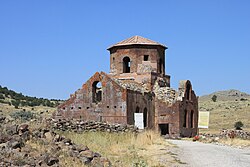
Constantinople, capital of the Byzantine Empire from 330/395 to 1453 AD, became established in the ecclesiastical hierarchy at the First Council of Constantinople in 381 AD. The historical origins of the Patriarchate of Constantinople go back to St. Andrew, Metrophanes and Alexander of Constantinople. Constantinople's primacy over the Patriarchates of Alexandria and Antioch was reaffirmed at the Council of Chalcedon in 481, after which the papacy in Rome supported Constantinople in its dispute with Alexandria over monophysitism. Later, when Rome sought to assert its primacy over Byzantium, the Eastern Orthodox Church developed the doctrine of pentarchy as a response.[127]
During the 8th and 9th centuries, Byzantium was embroiled in the Iconoclastic persecution.[128] The Photian schism was also 9th century power struggle for the Patriarchate between Ignatios, backed by Pope Nicholas I, and Photios I of Constantinople.[129][130]
The Byzantine Rite is similar to mass in the Catholic Church and the Divine Office (cycle of eight non-Mass services in the Catholic faith).[131] In addition to the Hours of the Office, the Byzantine Rite is used for the administration of sacraments; among these are Holy Communion (the most direct connection), baptism, Chrismation, confession, unction, matrimony, and ordination, as well as blessings, exorcisms, and other occasions.[132] The three divine liturgies of the Byzantine rite are John Chrysostom's, Basil's, and the Liturgy of the Presanctified Gifts.[132]
Roman Catholic Church
[edit]The Catholic Church in Turkey is represented by jurisdictions of Western and Eastern rites. Though the Armenian Apostolic Church was no longer in union with Rome and Byzantium after the Council of Chalcedon in 451 AD, a number of Armenian Christians have converted to Roman Catholicism over the years. After the Ottoman sultan Mahmud II extended formal recognition to Roman Catholics, an Armenian Catholic Patriarchate was established in Constantinople.[133][134]
- Latin rite:
- Vicariate Apostolic of Istanbul, with seat in the Cathedral of the Holy Spirit, Istanbul. Basilica: St. Anthony of Padua Church in Istanbul, Istanbul. Jurisdiction: Immediately subjected to the Holy See
- Vicariate Apostolic of Anatolia, with seat in the Cathedral of the Annunciation, İskenderun, and Co-Cathedral of St. Anthony of Padua, Mersin. Jurisdiction: Immediately subjected to the Holy See
- Roman Catholic Archdiocese of İzmir, with seat in the St. John's Cathedral, İzmir.
- Armenian rite: Armenian Catholic Archdiocese of Istanbul. Cathedral: Holy Mother of God Armenian Cathedral Church, Istanbul. Jurisdiction: Immediately subjected to the Holy See.
- Byzantine Rite: Greek Catholic Apostolic Exarchate of Istanbul. Cathedral: Holy Trinity Greek Catholic Cathedral, Istanbul (Ayatriada Rum Katoliki Kilise). Jurisdiction: Immediately subjected to the Holy See.
- Syriac Rite: Syrian Catholic Patriarchal Exarchate of Turkey, with seat in Istanbul. Jurisdiction: Subject to the Syriac Catholic Church.
- Chaldaean Rite: Chaldean Catholic Archdiocese of Diarbekir. Cathedral: St. Mary's Cathedral, Diyarbakır, but with seat in Beyoğlu, Istanbul. Jurisdiction: Chaldean Catholic Church.
Syriac Orthodox Church
[edit]
The Syriac Orthodox Church, that follows the West Syriac Rite, was present in various southeastern regions of modern Turkey since the early medieval times. Since the 12th century, the patriarchal seat itself was transferred to Mor Hananyo Monastery (Deir al-Za`faran), in southeastern Anatolia near Mardin (modern Turkey), where it remained until 1924. In modern times, active churches are located in Istanbul, Diyarbakır, Adıyaman, and Elazığ.[135] There are many both active and inactive churches in the traditionally Assyrian area of Tur Abdin, which is a region centered in the western area of Mardin Province, and has areas that go into Şırnak, and Batman Province. Up until the 1980s the Syriac population was concentrated there as well, but a large amount of the population has fled the region to Istanbul or abroad due to the Kurdish-Turkish conflict. The Church structure is still organized however, with 12 reverends stationed in churches and monasteries there.[136] Churches were also in several other provinces as well, but during the Seyfo the churches in those churches were destroyed or left ruined.
In modern times, Syriac Orthodox Church hase these provinces in Turkey:[137]
- Patriarchal Vicariate of Istanbul and Ankara under the spiritual guidance and direction of Archbishop Filüksinos Yusuf Çetin.
- Patriarchal Vicariate of Mardin under the spiritual guidance and direction of Archbishop Filüksinos Saliba Özmen.
- Patriarchal Vicariate of Turabdin under the spiritual guidance and direction of Archbishop Timotheus Samuel Aktaş.
- Archbishopric of Adıyaman under the spiritual guidance and direction of Archbishop Gregorius Melki Ürek.
Church of the East
[edit]Historical Church of the East, that followed the East Syriac Rite, was present in various southeastern regions of modern Turkey throughout medieval and early modern times, and the continuation of that presence is embodied in the modern Assyrian Church of the East, and the Ancient Church of the East. Ecclesiastical structure of East Syriac Christianity in the region was almost completely wiped out in the Assyrian genocide. Originally, one of its main centers was in the region of Hakkari, in the village of Qodchanis, that was the seat of Shimun-line patriarchs from the 17th century up to the advent of modern times. Patriarch Mar Dinkha IV of the Assyrian Church of the East visited Turkey in 2012.[138]
Protestant churches
[edit]Armenian Protestants own 3 churches in Istanbul since the 19th century.[139] There is an Alliance of Protestant Churches in Turkey.[140] There are Protestant churches for foreigners in compounds and resorts, although they are not counted in lists of churches as they are used only by tourists and expatriates.
Church of England
[edit]
Anglicans in Turkey form part of the Eastern Archdeaconry of the Diocese of Gibraltar in Europe. In 2008 the Anglican bishop of Europe, Geoffrey Rowell, caused controversy by ordaining a local man to minister to Turkish-speaking Anglicans in Istanbul.[141]
Evangelical churches
[edit]The Armenian Evangelical Church was founded in 1846, after Patriarch Matteos Chouhajian excommunicated members of the "Pietisical Union" who had started to raise questions about a possible conflicts between the Biblical scriptures and Sacred traditions.[133] The new church was recognized by the Ottoman government in 1850 after encouragement from the British Ambassador Henry Wellesley Cowley.[142] There were reportedly 15 Turkish converts in Constantinople in 1864. One church minister said "We wanted the Turks first to become Armenian". Hagop A. Chakmakjian commented that "the implication was that to be Christian meant to be identified with the Armenian people".[143]
The Church of Jesus Christ of Latter-day Saints
[edit]Recognizing that present-day Ephesus of the New Testament endowed Turkey with historical importance, early leaders of the LDS Church preached in Ottoman Turkey in 1850, and—with the help of British LDS soldiers—organized a congregation in Istanbul in 1854.[144] In 1979, another local community of LDS adherents was organized in Ankara.[144]
List of church buildings in Turkey
[edit]Churches of the Armenian rite
[edit]| Church name | Picture | Status |
|---|---|---|
| Church of the Apparition of the Holy Cross (Kuruçeşme, Istanbul) Yerevman Surp Haç Ermeni Kilisesi |
active | |
| Holy Archangels Armenian Church (Balat, Istanbul) Surp Hıreşdagabed Ermeni Kilisesi |
active | |
| Holy Cross Armenian Church (Kartal, Istanbul) Surp Nişan Ermeni Kilisesi |
active | |
| Holy Cross Armenian Church (Üskudar, Istanbul) Surp Haç Ermeni Kilisesi |
active | |
| Holy Hripsimiants Virgins Armenian Church (Büyükdere, Istanbul) Surp Hripsimyants Ermeni Kilisesi |
active | |
| Holy Mother-of-God Armenian Apostolic Church (Bakırköy, Istanbul) Surp Asdvadzadzin Ermeni Kilisesi |
active | |
| Holy Mother-of-God Armenian Church (Beşiktaş, Istanbul) Surp Asdvadzadzin Ermeni Kilisesi |
active | |
| Holy Mother-of-God Armenian Church (Eyüp, Istanbul) Surp Asdvadzadzin Ermeni Kilisesi |
active | |
| Holy Mother-of-God Armenian Church (Ortaköy, Istanbul) Surp Asdvadzadzin Ermeni Kilisesi |
active | |
| Holy Mother-of-God Armenian Church (Yeniköy, Istanbul) Surp Asdvadzadzin Ermeni Kilisesi |
active | |
| Holy Resurrection Armenian Church (Kumkapı, Istanbul) Surp Harutyun Ermeni Kilisesi |
active | |
| Holy Resurrection Armenian Church (Taksim, Istanbul) Surp Harutyun Ermeni Kilisesi |
active | |
| Holy Three Youths Armenian Church (Boyacıköy, Istanbul) Surp Yerits Mangants Ermeni Kilisesi |
active | |
| Holy Trinity Armenian Church (Galatasaray, Istanbul) Surp Yerrortutyun Ermeni Kilisesi |
active | |
| Narlıkapı Armenian Apostolic Church (Narlıkapı, Istanbul) Surp Hovhannes Ermeni Kilisesi |
active | |
| St. Elijah The Prophet Armenian Church (Eyüp, Istanbul) Surp Yeğya Ermeni Kilisesi |
active | |
| St. Garabed Armenian Church (Üsküdar, Istanbul) Surp Garabet Ermeni Kilisesi |
active | |
| St. John The Evangelist Armenian Church (Gedikpaşa, Istanbul) Surp Hovhannes Ermeni Kilisesi |
active | |
| St. Gregory The Enlightener Armenian Church (Galata, Istanbul) | active | |
| St. Gregory The Enlightener Armenian Church (Kuzguncuk, Istanbul) Surp Krikor Lusaroviç Ermeni Kilisesi |
active | |
| St. Gregory The Enlightener Armenian Church (Karaköy, Istanbul) Surp Krikor Lusavoriç Ermeni Kilisesi |
active | |
| St. Gregory The Enlightener Armenian Church (Kınalıada, Istanbul) Surp Krikor Lusavoriç Ermeni Kilisesi |
active | |
| St. James Armenian Church (Altımermer, Istanbul) Surp Hagop Ermeni Kilisesi |
active | |
| St. Nicholas Armenian Church (Beykoz, Istanbul) Surp Nigoğayos Ermeni Kilisesi |
active | |
| St. Nicholas Armenian Church (Topkapı, Istanbul) Surp Nigoğayos Ermeni Kilisesi |
active | |
| St. Santoukht Armenian Church (Rumelihisarı, Istanbul) Surp Santuht Ermeni Kilisesi |
active | |
| St. Saviour Armenian Chapel (Yedikule, Istanbul) Surp Pırgiç Ermeni Kilisesi |
active | |
| St. Sergius Armenian Chapel (Balıklı, Istanbul) Surp Sarkis Anıt Mezar Şapeli |
active | |
| St. Stephen Armenian Church (Karaköy, Istanbul) Surp Istepanos Ermeni Kilisesi |
active | |
| St. Stephen Armenian Church (Yeşilköy, Istanbul) Surp Istepanos Ermeni Kilisesi |
active | |
| St. Takavor Armenian Apostolic Church (Kadıkoy, Istanbul) Surp Takavor Ermeni Kilisesi |
active | |
| Saints Thaddeus and Barholomew Armenian Church (Yenikapı, Istanbul) Surp Tateos Partoğomeos Ermeni Kilisesi |
active | |
| St. Vartanants Armenian Church (Feriköy, Istanbul) Surp Vartanants Ermeni Kilisesi |
active | |
| The Twelve Holy Apostles Armenian Church (Kandilli, Istanbul) Surp Yergodasan Arakelots Ermeni Kilisesi |
active | |
| Holy Forty Martyrs of Sebastea Armenian Church (Iskenderun, Hatay) Surp Karasun Manuk Ermeni Kilisesi |
active | |
| St. George Armenian Church (Derik, Mardin) Surp Kevork Ermeni Kilisesi |
active | |
| St. Gregory The Enlightener Armenian Church (Kayseri) Surp Krikor Lusavoriç Ermeni Kilisesi |
active | |
| St. Gregory The Enligtener Armenian Church (Kırıkhan, Hatay) Surp Krikor Lusavoriç Kilisesi |
active | |
| Church of St. George of Samatya (Samatya, Istanbul) Surp Kevork Kilisesi |
active | |
| St. Giragos Armenian Church (Diyarbakır) Surp Giragos Ermeni Kilisesi |
 |
active |
| Vakıflı Church Vakıflıköy Ermeni Kilisesi |
 |
active |
| Cathedral of Kars | 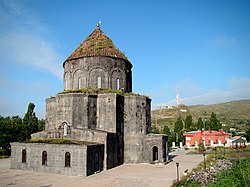 |
converted into a mosque |
| Narekavank |  |
destroyed, mosque built on the site |
| Cathedral of Ani |  |
UNESCO World Heritage Site |
| Virgin Mary Church, Kayseri | 
|
museum (converted into a library) |
| St. John the Baptist Armenian Church (Uskudar) | unknown | |
| Ktuts monastery |  |
abandoned |
| Cathedral of Mren |  |
ruins |
| Holy Apostles Monastery |  |
ruins |
| Horomos |  |
ruins |
| Karmravank (Vaspurakan) |  |
ruins |
| Kaymaklı Monastery | ruins | |
| Khtzkonk Monastery | ruins | |
| Varagavank |  |
ruins |
| Saint Bartholomew Monastery | 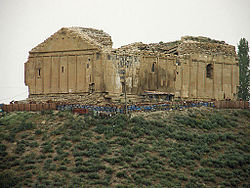
|
ruins |
| St. Marineh Church, Mush | ruins | |
| Saint Karapet Monastery | 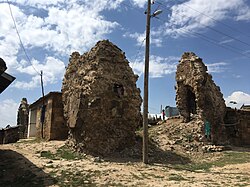
|
destroyed, village built on the site |
| St. Stepanos Church | 
|
destroyed |
| Tekor Basilica |  |
destroyed |
| Vank Church in Şenkaya | destroyed by treasure hunters in 2021[145] |
Churches of the Byzantine and Greek Orthodox rite
[edit]| Church name | Picture | Status |
|---|---|---|
| Church of St. George, Istanbul | 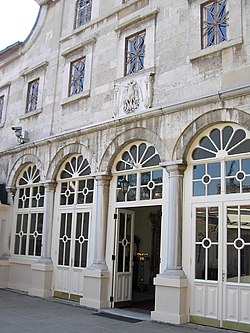 |
active |
| Church of St. Mary of Blachernae (Istanbul) | 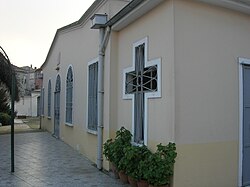 |
active |
| Church of St. Mary of the Mongols |  |
active |
| İskenderun St. Nicholas Church[146] | 
|
damaged due to 2023 Turkey–Syria earthquake |
| Mersin Orthodox Church | 
|
active |
| Church of St. Kyriaki, Istanbul | 
|
active |
| Meryem Ana Church | 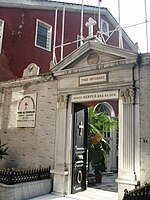 |
active |
| Bulgarian St. Stephen Church |  |
active |
| St. Demetrius Church in Feriköy, Istanbul | 
|
active |
| Hagia Triada Greek Orthodox Church in Beyoğlu, Istanbul | 
|
active |
| Panayia Evangelistria in Beyoğlu, Istanbul | 
|
active. Built in 1893.[147] |
| Saint Andrew in Krisei | 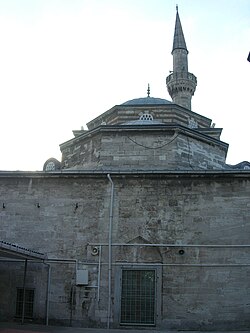 |
converted into a mosque |
| Chora Church |  |
converted into a mosque |
| Church of Christ Pantokrator (Constantinople) | 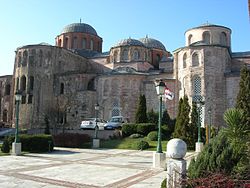 |
converted into the Zeyrek Mosque |
| Church of Christ Pantepoptes (Constantinople) | 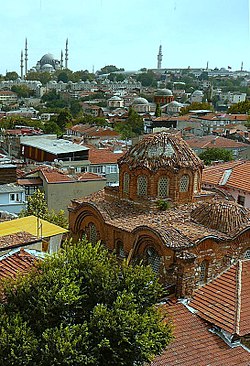 |
converted into a mosque |
| Monastery of Gastria |  |
converted into a mosque |
| Hagia Sophia |  |
converted into a mosque |
| Church of the Holy Apostles | demolished, Fatih Mosque built on top | |
| Church of Saint John the Baptist at Lips (Constantinople) | 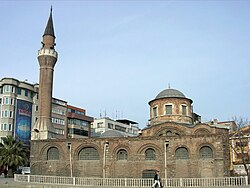 |
converted into a mosque |
| Monastery of Stoudios |  |
to be converted into a mosque |
| Church of Saint John the Baptist en to Trullo (Constantinople) | 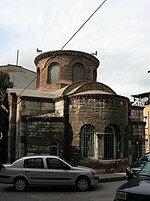 |
converted into a mosque |
| Myrelaion |  |
converted into a mosque |
| Church of Saint Nicholas of the Caffariotes (Istanbul) |  |
converted into a mosque |
| Pammakaristos Church |  |
converted into a mosque |
| Church of Sergius and Bacchus | 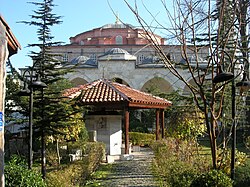 |
converted into a mosque |
| Saint Irene church |  |
converted into a mosque |
| Church of Vefa |  |
converted into a mosque |
| Holy Martyrs Menodora, Metrodora, and Nymphodora | 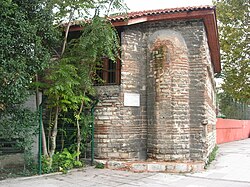 |
converted into a mosque |
| Saint Mary of Constantinople |  |
converted into a mosque |
| Church of Hagia Thekla tu Palatiu ton Blakhernon |  |
converted into a mosque |
| Church of Hagios Theodoros (Constantinople) |  |
converted into a mosque |
| Church of Hagias Theodosias en tois Dexiokratus |  |
converted into a mosque |
| Church of Saint Thomas |  |
converted into a mosque |
| Church of the Theotokos Kyriotissa (Constantinople) |  |
converted into a mosque |
| Nakip Mosque | converted into a mosque | |
| Hagios Eugenios Church | 
|
converted into a mosque |
| Panagia Chrysokephalos Church | 
|
converted into a mosque |
| Virgin Mary Church | 
|
converted into a mosque |
| Hagia Sophia, Trabzon | 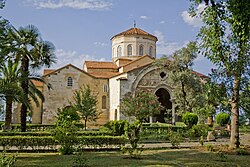
|
converted into a mosque |
| Hagia Sophia, İznik | 
|
converted into a mosque |
| Church of Christ and Saint Stephen | 
|
converted into a mosque |
| Toklu Dede Mosque | converted into a mosque (before was a church of unknown dedication) | |
| Alâeddin Mosque | 
|
converted into a mosque (before was a basilica of unknown dedication) |
| Saint Paul Cathedral | 
|
converted into a mosque |
| Aya Panagia Greek Church (Yaman Dede Mosque), Talas, Kayseri | 
|
converted into a mosque |
| St. Gregory of Nazianzos Church, (Kilise Camii), Güzelyurt, Aksaray. | 
|
converted into a mosque |
| Hagia Irene | 
|
museum |
| Sümela Monastery | 
|
museum |
| Virgin Mary Monastery | museum | |
| House of the Virgin Mary | 
|
museum |
| Church of St Nicholas of Myra(Santa Claus) (Demre) | 
|
ruins, museum |
| Taşbaşı Church, Ordu province | 
|
museum |
| Saint John's Church, Gülşehir | museum | |
| Saint Michael Church in Akçaabat | now used for social and cultural activities and museum by the Turkish Ministry of Culture and Tourism, built in 1332[148] | |
| Saint Voukolos Church | 
|
now used for social and cultural activities |
| Kuruköprü Monumental Church | 
|
museum |
| Saint Paul's Church, Tarsus | 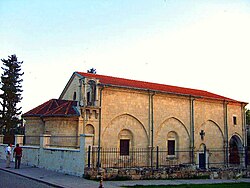
|
museum |
| Ayazma Church (Faneromeni Church) in Ayvalık | After Greeks left in 1925 due to the Population exchange between Greece and Turkey, it turned into an olive oil factory, for a period, and because of that the interior of the building changed. There are plans to be turned into a museum. | |
| Church of St. Polyeuctus | 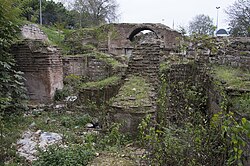
|
archaeological site |
| Church of St. Jean at Ayasuluk Hill | archaeological site. The current building dates back to the Emperor Justinian I, but there was a church building even before that.[149] | |
| Church of the Apostles at Anazarbus | archaeological site.[150] | |
| Churches of Göreme | archaeological sites. In Göreme at Cappadocia there are a lot of old Greek churches. | |
| Basilica of St. John | 
|
archaeological site |
| Çanlı Kilise | 
|
archaeological site |
| Cave monastery of İnceğiz | 
|
archaeological site |
| Gümüşler Monastery | 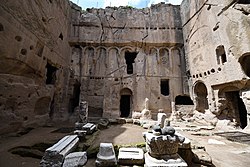
|
archaeological site |
| Eskigümüş Monastery | archaeological site | |
| 35 churches and chapels in caves at the Ayazini | archaeological site[151] | |
| Church on the Küçük Tavşan Adası | archaeological site. A church of the 6th century.[152][153] | |
| Selime Cathedral at the Ihlara Valley in Cappadocia | 
|
archaeological site[154] |
| Virgin Mary Church at the Ihlara Valley in Cappadocia | archaeological site[155] | |
| Chapel at Bağcılar | archaeological site. In 2023, a Greek chapel has been discovered at Bağcılar in Istanbul.[156] | |
| Underwater basilica in Iznik Lake | archaeological site. It was built sometime after 390 AD and destroyed in a big earthquake in 1065.[157] | |
| Saint George Church at Diyarbakır | built around 200 AD, now an art gallery[158] | |
| Bodrum Aya Nikola Church[TR] | 
|
museum |
| Saint Analipsis Church (Yüksek Kilise), Aksaray | 
|
museum |
| Niğde Prodromos Church | 
|
museum |
| St. Theodore Church (Üzümlü Kilise), Derinkuyu | 
|
museum |
| Panagia Theoskepastos Monastery, Trabzon | 
|
archaeological site. |
| Saint Anne Church, Trabzon | 
|
museum |
| Jason Church | 
|
museum |
| Vazelon Monastery | 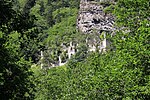
|
archaeological site. |
| Meryem Ana Monastery | archaeological site. | |
| Sinope Koimesis Church | 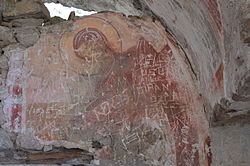
|
archaeological site. |
| Çakırkaya Monastery, Gümüşhane[159] | museum.[160] | |
| Üzümlü Church | museum. | |
| Church within Kaymakli/Anakou Underground City | museum. | |
| Hagia Triada Church, Ayvalık | ongoing restoration. | |
| Church of St. John, Tirilye | transferred to private property after the Greek population was expelled in 1923 and now is a residence | |
| St. Basil's Church, Tirilye | became a Stone School (being used for the workshops for carpentry and iron works) and the "Dündar House" (used as a mess house) | |
| Palace of Antiochos | a hotel is on top of the ruins but some traces of the palace can be seen under a glass floor at the dining hall. | |
| Niğde Küçükköy Church | 
|
abandoned |
| Church of the Virgin of the Pharos | ruins | |
| Kuştul Monastery | 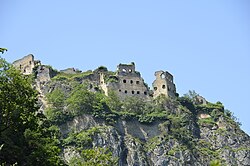
|
ruins |
| Göreği Monastery, Fatsa district | ruins | |
| Pavrezi Chapel, Gümüşhane[159] | ruins | |
| Hagios Georgios Monastery, Gümüşhane[159] | ruins | |
| Panagia Monastery, Gümüşhane[159] | ruins | |
| Seven or more ruined churches in Santa[161] | ruins | |
| Kamışlı Kilisesi/Çakrak Church, Alucra district | ruins | |
| Üçayak Byzantine Church | 
|
ruins |
| Hasanaliler Church | 
|
ruins |
| Hodegon Monastery | ruins | |
| Pelekete monastery | ruins | |
| Medikion monastery | ruins | |
| Batheos Rhyakos Monastery | ruins, some buildings are used as animal shelters | |
| Kaman Demirli Church (Kilise Kalıntıları), Kaman | 
|
ruins of unknown dedication. |
| Saint Demetrius Monastery on Cunda Island | ruins, built in 1766 destroyed by treasure hunters in 2020[162] | |
| Saint Georgios Church in Nilüfer, Bursa | ruins, built in 1896 and fell down in 2020, because it was neglected[163] | |
| Hutura Hagios Monastery Church in Gümüşhane | ruins, built in the 14th century, it is often plundered by treasure hunters. The library of the monastery is also destroyed.[164] | |
| St. Yuannis Church (Aziz Yuannis Kilisesi) or St. John the Russian Church, Ürgüp | ruins | |
| St. Spyridon Church (Kizil Kilise), Güzelyurt. | 
|
ruins |
| Saint Gregory of Nyssa Church, Trabzon | 
|
destroyed |
| Heliou Bomon monastery | destroyed |
Catholic churches
[edit]| Church name | Picture | Status |
|---|---|---|
| Church of Santa Maria, Trabzon | active | |
| Virgin Mary Latin Catholic Church (Tubini Şapeli), Kadıköy | active | |
| Cathedral of the Holy Spirit, Istanbul | 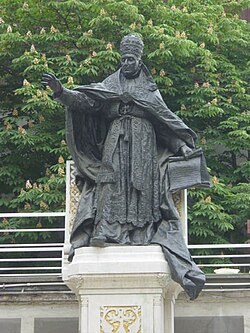 |
active |
| St. Anthony of Padua Church in Istanbul |  |
active |
| Cathedral of the Annunciation, İskenderun |  |
damaged due to 2023 Turkey–Syria earthquake |
| Church of St. Anthony, Mersin |  |
active |
| St. John's Cathedral, İzmir |  |
active |
| Church of SS Peter and Paul, Istanbul |  |
active |
| Church of Saint Benoit, Istanbul | 
|
active |
| Church of St. Mary Draperis, Istanbul | 
|
active |
| Saint Paul Church, Adana | 
|
active |
| St. Mary's Church, İzmir | 
|
active |
| St. Térèse Church, Ankara | 
|
active |
| St. George's Catholic Church | 
|
active[165] |
| Notre-Dame de L'Assomption, İstanbul | 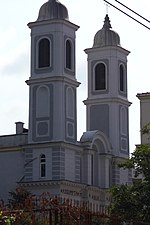
|
active |
| Church of San Domenico (Constantinople) |  |
converted into a mosque |
| Church of St Peter |  |
museum |
Churches of the Georgian rite
[edit]
| Church name | Picture | Status |
|---|---|---|
| Our Lady of Lourdes Church, Istanbul (Bomonti Gürcü Katolik Kilisesi) |  |
active |
| Khakhuli Monastery (Haho/Bağbaşı) |  |
converted into a mosque |
| Doliskana (Dolishane/Hamamlıköy) |  |
converted into a mosque |
| Ishkhani (İşhan) |  |
protected
(since 1987)[167] |
| Parkhali (Barhal/Altıparmak) |  |
protected[168] |
| Oshki (Öşki Manastırı/Öşk Vank/Çamlıyamaç) |  |
protected |
| Otkhta Eklesia (Dörtkilise) | 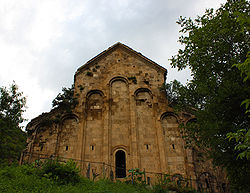 |
abandoned |
| Khandzta |  |
ruins |
| Ekeki |  |
ruins |
| Parekhi |  |
ruins |
| Makriali St. George church, Kemalpaşa, Artvin |  |
ruins |
| St. Barlaam Monastery (Barlaham Manastırı), Yayladağı | ruins | |
| Ancha monastery |  |
ruins |
| Okhvame, Ardeşen |  |
ruins |
| Tskarostavi monastery |  |
ruins |
| Bana cathedral (Penek) |  |
ruins |
| Tbeti Monastery (Cevizli) |  |
ruins |
| old Georgian Church, Ani |  |
ruins |
| Opiza |  |
ruins |
Protestant churches
[edit]Anglican churches
[edit]| Church name | Picture | Status |
|---|---|---|
| Christ Church, Istanbul |  |
active |
| St. John the Evangelist's Anglican Church, İzmir |  |
active |
Other churches
[edit]| Church name | Picture | Status |
|---|---|---|
| Buca Protestant Baptist Church[TR] |  |
active |
| Kreuzkirche, İstanbul[DE] |  |
active |
| Samsun Protestant Church |  |
active |
| Church of the Resurrection, İzmir |  |
active |
| All Saints' Church, Moda |  |
active |
Churches of the Syriac rite
[edit]| Church name | Picture | Status |
|---|---|---|
| Mor Sharbel Syriac Orthodox church in Midyat |  |
active |
| Mor Gabriel Monastery |  |
active |
| Mor Ephrem Syriac Orthodox Church, Yeşilköy, Istanbul |  |
active[169] |
| Mor Hananyo Monastery |  |
active |
| Mor Yuhanna Monastery in Eğil | museum[170] | |
| Zuqnin Monastery |
List of settlements
[edit]Significant Christian population
[edit]Majority Christian population
[edit]Majority Christian population
[edit]- Anıtlı, Midyat
- Beth Kustan, Midyat
- Elbeğendi, Midyat
- Gülgöze, Midyat
- Taşköy, Nusaybin
- Üçköy, Nusaybin
- Üçyol, Nusaybin
- Dağiçi, Nusaybin
- Bülbül, Yeşilli
- Dereiçi, Savur
- Çatalçam, Dargeçit
Significant Christian population
[edit]- Altıntaş, Midyat
- Bardakçı, Midyat
- Barıştepe, Midyat
- Budaklı, Midyat
- Doğançay
- Güngören, Midyat
- İzbırak, Midyat
- Narlı, Midyat
- Mercimekli, Midyat
- Ortaca, Midyat
- Yemişli, Midyat
- Dibek, Nusaybin
- Odabaşı, Nusaybin
- Girmeli, Nusaybin
- Günyurdu, Nusaybin
Majority Christian population
[edit]See also
[edit]- Catholic Church in Turkey
- Christianity and Islam
- Christianity in Cyprus
- Christianity in the Ottoman Empire
- Eastern Orthodoxy in Turkey
- Freedom of religion in Turkey
- Human rights in the Middle East
- Human rights in Muslim-majority countries#Turkey
- Human rights in Turkey#Freedom of religion
- Irreligion in Turkey
- Islam and other religions
- Islam in Turkey
- Karamanlides, a Turkish-speaking Greek Orthodox community
- Nestorian rebellion
- Persecution of Christians in the Muslim world
- Protestantism in Turkey
- Religion in the Middle East
- Religion in Turkey
- Religious minorities in Turkey
- Secularism in Turkey
- Xenophobia and discrimination in Turkey
- Xenophobia and racism in the Middle East
References
[edit]- ^ a b "Religious Composition by Country, 2010-2050". December 21, 2022.
- ^ a b "The Global Religious Landscape". Archived from the original on September 28, 2018.
- ^ a b c d e f g h i j k l m n Bardakçı, Mehmet; Freyberg-Inan, Annette; Giesel, Christoph; Leisse, Olaf (2017). "The Ambivalent Situation of Turkey's Armenians: Between Collective Historical Trauma and Psychological Repression, Loyal Citizenship and Minority Status, Social Integration and Discrimination, Assimilation and Self-assertion". Religious Minorities in Turkey: Alevi, Armenians, and Syriacs and the Struggle to Desecuritize Religious Freedom. London and New York: Palgrave Macmillan. pp. 133−154. doi:10.1057/978-1-137-27026-9_5. ISBN 978-1-137-27026-9. LCCN 2016961241.
- ^ a b c d e f g h Erol, Su (2015). "The Syriacs of Turkey: A Religious Community on the Path of Recognition". Archives de sciences sociales des religions (171). Paris, France: Éditions de l'EHESS: 59–80. doi:10.4000/assr.27027. ISBN 9782713224706. ISSN 1777-5825. Archived from the original on June 26, 2019.
- ^ a b "The Global Religious Landscape". ResearchGate. Archived from the original on April 2, 2020. Retrieved February 8, 2019.
- ^ "National Profiles | World Religion". www.thearda.com. Retrieved August 23, 2024.
- ^ "Türkiye'de Hristiyan nüfusu ve kilise sayısı - Demokrat Gündem - Haberler - Son Dakika Haberleri". demokratgundem.com (in Turkish). June 19, 2023. Retrieved August 23, 2024.
- ^ https://cdn.teyit.org/wp-content/uploads/2019/11/nufustahriri.pdf
- ^ "Türkiye farklı inançlara sağlanan ibadet yeri sayısında Batı'nın 5 kat önünde". www.aa.com.tr. Retrieved August 23, 2024.
- ^ a b "Turkey (Türkiye)". www.state.gov. Washington, D.C.: U.S. Department of State. 2023. Archived from the original on January 18, 2025. Retrieved January 21, 2025.
- ^ a b c d e f g h Bulut, Uzay (August 30, 2024). "Turkey: Ongoing Violations against Greek Christians". The European Conservative. Budapest, Brussels, Rome, Vienna: Center for European Renewal. ISSN 2590-2008. Archived from the original on August 30, 2024. Retrieved August 30, 2024.
- ^ a b c d e Morris, Benny; Ze'evi, Dror (November 4, 2021). "Then Came the Chance the Turks Have Been Waiting For: To Get Rid of Christians Once and for All". Haaretz. Tel Aviv. Archived from the original on November 4, 2021. Retrieved November 5, 2021.
- ^ a b c d Morris, Benny; Ze'evi, Dror (2019). The Thirty-Year Genocide: Turkey's Destruction of Its Christian Minorities, 1894–1924. Cambridge, Massachusetts: Harvard University Press. pp. 3–5. ISBN 978-0-674-24008-7.
- ^ a b c d e Gutman, David (2019). "The thirty year genocide: Turkey's destruction of its Christian minorities, 1894–1924". Turkish Studies. 21 (1). London and New York: Routledge on behalf of the Global Research in International Affairs Center: 1–3. doi:10.1080/14683849.2019.1644170. eISSN 1743-9663. ISSN 1468-3849. S2CID 201424062.
- ^ a b c d e Smith, Roger W. (Spring 2015). "Introduction: The Ottoman Genocides of Armenians, Assyrians, and Greeks". Genocide Studies International. 9 (1). Toronto: University of Toronto Press: 1–9. doi:10.3138/GSI.9.1.01. ISSN 2291-1855. JSTOR 26986011. S2CID 154145301.
- ^ a b c d e Roshwald, Aviel (2013). "Part II. The Emergence of Nationalism: Politics and Power – Nationalism in the Middle East, 1876–1945". In Breuilly, John (ed.). The Oxford Handbook of the History of Nationalism. Oxford and New York: Oxford University Press. pp. 220–241. doi:10.1093/oxfordhb/9780199209194.013.0011. ISBN 9780191750304. Archived from the original on January 15, 2023. Retrieved January 2, 2023.
- ^ a b c d e f g h i Üngör, Uğur Ümit (June 2008). "Seeing like a nation-state: Young Turk social engineering in Eastern Turkey, 1913–50". Journal of Genocide Research. 10 (1). London and New York: Routledge: 15–39. doi:10.1080/14623520701850278. ISSN 1469-9494. OCLC 260038904. S2CID 71551858.
- ^ a b c d e f İçduygu, Ahmet; Toktaş, Şule; Ali Soner, B. (February 2008). "The politics of population in a nation-building process: Emigration of non-Muslims from Turkey". Ethnic and Racial Studies. 31 (2). London and New York: Routledge: 358–389. doi:10.1080/01419870701491937. ISSN 1466-4356. OCLC 40348219. S2CID 143541451. Archived from the original on March 25, 2020. Retrieved August 2, 2020 – via Academia.edu.
- ^ [3][4][11][12][13][14][15][16][17][18]
- ^ [3][4][11][12][13][14][15][16][17][18]
- ^ Chapter: The refugees question in Greece (1821–1930) in "Θέματα Νεοελληνικής Ιστορίας", ΟΕΔΒ ("Topics from Modern Greek History"). 8th edition (PDF), Nikolaos Andriotis, 2008
- ^ Quarterly, Middle East (2001). "Editors' Introduction: Why a Special Issue?: Disappearing Christians of the Middle East" (PDF). Middle East Quarterly. Archived from the original on May 11, 2013. Retrieved June 11, 2013.
- ^ a b c d "Fearing a new holy empire: Just when Turks are worried about Christians, here comes the Pope". Maclean's. December 4, 2006. Archived from the original on July 19, 2021. Retrieved May 25, 2022.
More tangibly, figures published in January 2004 in Turkey's mainstream Milliyet newspaper claimed that 35,000 Muslims, the vast majority of them in Istanbul, had converted to Christianity in 2003. While impossible to confirm (the Turkish government does not release these figures), the rate of conversion, according to Christian leaders in Turkey, is on the rise.
- ^ a b c "Turkish Protestants still face "long path" to religious freedom". christiancentury.org. Archived from the original on October 17, 2014. Retrieved November 3, 2014.
- ^ "Christian persecution – Turkey". www.opendoorsusa.org. 2015. Archived from the original on April 7, 2015. Retrieved January 28, 2021.
- ^ Khalil, Mohammad H.; Bilici, Mucahit (2007). "Conversion Out of Islam: A Study of Conversion Narratives of Former Muslims" (PDF). The Muslim World. 97 (1). Chichester, West Sussex: Wiley-Blackwell: 111–124. doi:10.1111/j.1478-1913.2007.00161.x. hdl:2027.42/72141. ISSN 0027-4909. Archived from the original on September 28, 2024. Retrieved January 15, 2025.
- ^ [3][4][11][12][13][14][15][16][17][18]
- ^ [3][4][11][12][13][14][15][16][17][18]
- ^ Chapter The refugees question in Greece (1821–1930) in "Θέματα Νεοελληνικής Ιστορίας", ΟΕΔΒ ("Topics from Modern Greek History"). 8th edition (PDF). Nikolaos Andriotis. 2008.
- ^ "'Editors' Introduction: Why a Special Issue?: Disappearing Christians of the Middle East". Middle East Quarterly. 2001. Archived from the original on May 11, 2013. Retrieved June 11, 2013.
- ^ Turkey's compliance with its obligations yale.edu
- ^ Situation of regional or minority languages in Europe coe.int
- ^ "Global Christianity - A Report on the Size and Distribution of the World's Christian Population" (PDF). Pew Research Center. Archived (PDF) from the original on February 1, 2021. Retrieved June 2, 2022.
- ^ a b c "Foreign Ministry: 89,000 minorities live in Turkey". Today's Zaman. December 15, 2008. Archived from the original on May 20, 2011. Retrieved May 16, 2011.
- ^ "Türkiye'de ortaya çıkan Rum Ortodoks Kilisesi kim veya nedir?". Archived from the original on November 9, 2021. Retrieved January 2, 2023.
- ^ "Türkiye'nin din haritası çizildi". October 28, 2009. Archived from the original on January 2, 2023. Retrieved January 2, 2023.
- ^ "Statistics by Country". www.catholic-hierarchy.org. Archived from the original on December 18, 2016. Retrieved February 18, 2015.
- ^ "Christen in der islamischen Welt – Aus Politik und Zeitgeschichte" (PDF). 2008. Archived from the original on May 2, 2014. Retrieved June 11, 2013.
- ^ "2021 Country and Territory Reports". JW.ORG. 2021. Archived from the original on December 30, 2021. Retrieved November 4, 2022.
- ^ "Statistics and Church Facts | Total Church Membership". newsroom.churchofjesuschrist.org. Archived from the original on June 28, 2019. Retrieved August 24, 2021.
- ^ a b "International Institute for Religious Freedom: Single Post". Iirf.eu. Archived from the original on July 8, 2015. Retrieved August 11, 2015.
- ^ a b Johnstone, Patrick; Miller, Duane Alexander (2015). "Believers in Christ from a Muslim Background: A Global Census". Interdisciplinary Journal of Research on Religion. 11: 17. Archived from the original on November 26, 2015. Retrieved October 20, 2015.
- ^ "Life, Culture, Religion". Official Tourism Portal of Turkey. April 15, 2009. Archived from the original on April 15, 2009. Retrieved February 9, 2013.
- ^ William G. Rusch (2013). The Witness of Bartholomew I, Ecumenical Patriarch. Wm. B. Eerdmans Publishing. p. 31. ISBN 978-0-8028-6717-9. Archived from the original on January 15, 2023. Retrieved July 24, 2018.
Constantinople has been the seat of an archiepiscopal see since the fourth century; its ruling hierarch has had the title of"Ecumenical Patriarch" ...
- ^ Erwin Fahlbusch; Geoffrey William Bromiley (2001). The Encyclopedia of Christianity. Wm. B. Eerdmans Publishing. p. 40. ISBN 978-90-04-11695-5. Archived from the original on January 15, 2023. Retrieved July 24, 2018.
The Ecumenical Patriarchate of Constantinople is the ranking church within the communion of ... Between the 4th and 15th centuries, the activities of the patriarchate took place within the context of an empire that not only was ...
- ^ "Türkiye farklı inançlara sağlanan ibadet yeri sayısında Batı'nın 5 kat önünde". www.aa.com.tr. Retrieved August 23, 2024.
- ^ a b c "Turkey (Türkiye)". Retrieved February 19, 2024.
- ^ "Turkey: Freedom in the World 2022 Country Report". Freedom House. Retrieved February 19, 2024.
- ^ AA, Daily Sabah with (October 4, 2023). "Türkiye's 1st Orthodox church built in post-republic era set to open". Daily Sabah. Retrieved October 5, 2023.
- ^ a b c d Teule, Herman G. B. (2014). "Christianity in Western Asia". The Oxford Handbook of Christianity in Asia. Oxford and New York: Oxford University Press. doi:10.1093/oxfordhb/9780199329069.013.0001. ISBN 9780199329069. Archived from the original on June 5, 2018. Retrieved July 25, 2018.
- ^ Talbot, Alice-Mary (October 23, 2008). "Hagiography". The Oxford Handbook of Byzantine Studies. doi:10.1093/oxfordhb/9780199252466.013.0082. Archived from the original on June 2, 2018. Retrieved July 25, 2018.
- ^ Kurian, George Thomas; Lamport, Mark A. (November 10, 2016). Encyclopedia of Christianity in the United States. Rowman & Littlefield. ISBN 978-1-4422-4432-0. Archived from the original on January 15, 2023. Retrieved July 25, 2018.
- ^ Parry, Ken (2009). Christianity: Religions of the World. Infobase Publishing. p. 139. ISBN 9781438106397.
- ^ Parry, Ken (2010). The Blackwell Companion to Eastern Christianity. John Wiley & Sons. p. 368. ISBN 9781444333619.
- ^ Pounds, Norman John Greville. An Historical Geography of Europe, 1500–1840, p. 124. CUP Archive, 1979. ISBN 0-521-22379-2.
- ^ Janin (1964), passim
- ^ "Preserving The Intellectual Heritage--Preface • CLIR". CLIR. Archived from the original on October 20, 2017. Retrieved June 9, 2021.
- ^ Laiou, Angeliki E.; Morisson, Cécile (2007). The Byzantine Economy. Cambridge, England: Cambridge University Press. ISBN 978-0-521-84978-4..
- ^ Meyendorff 1982, p. 13.
- ^ Meyendorff 1982, p. 19.
- ^ Farmer, David Hugh (April 14, 2011). Forty Martyrs of Sebaste – Oxford Reference. OUP Oxford. ISBN 9780199596607. Archived from the original on April 14, 2022. Retrieved July 24, 2018.
- ^ a b Runciman, Steven (1965). The Fall of Constantinople 1453. Cambridge University Press. pp. 145–148. ISBN 978-0-521-39832-9. Archived from the original on January 15, 2023. Retrieved September 22, 2020.
- ^ Nicol, Donald MacGillivray (1979). The End of the Byzantine Empire. London: Edward Arnold. p. 88. ISBN 978-0-7131-6250-9. Archived from the original on January 15, 2023. Retrieved September 22, 2020.
- ^ Inalcik, Halil (1969). "The Policy of Mehmed II toward the Greek Population of Istanbul and the Byzantine Buildings of the City". Dumbarton Oaks Papers. 23/24: 229–249. doi:10.2307/1291293. ISSN 0070-7546. JSTOR 1291293. Archived from the original on October 17, 2021. Retrieved July 26, 2020.
- ^ a b Nicol. The End of the Byzantine Empire, p. 90.
- ^ a b Runciman, Steven (1965). The Fall of Constantinople 1453. Cambridge University Press. p. 147. ISBN 978-0-521-39832-9. Archived from the original on January 15, 2023. Retrieved September 22, 2020.
- ^ Runciman. The Fall of Constantinople, pp. 133–34.
- ^ Nicol, Donald M. The Last Centuries of Byzantium 1261–1453. Cambridge: Cambridge University Press, 1972, p. 389.
- ^ Smith, Cyril J. (1974). "History of Rape and Rape Laws". Women Law Journal. No. 60. p. 188. Archived from the original on April 26, 2020. Retrieved October 12, 2020.
- ^ Mansel, Philip. "Constantinople: City of the World's Desire 1453–1924". Washington Post. Archived from the original on July 24, 2019. Retrieved August 7, 2020.
- ^ Roger Crowley (August 6, 2009). Constantinople: The Last Great Siege, 1453. Faber & Faber. p. 226. ISBN 978-0-571-25079-0.
The vast majority of the ordinary citizens - about 30,000 - were marched off to the slave markets of Edirne, Bursa and Ankara.
- ^ M.J Akbar (May 3, 2002). The Shade of Swords: Jihad and the Conflict Between Islam and Christianity. Routledge. p. 86. ISBN 978-1-134-45259-0. Archived from the original on October 12, 2020. Retrieved August 6, 2020.
Some 30,000 Christians were either enslaved or sold.
- ^ Jim Bradbury (1992). The Medieval Siege. Boydell & Brewer. p. 322. ISBN 978-0-85115-312-4. Archived from the original on January 15, 2023. Retrieved May 4, 2021.
- ^ a b c d One or more of the preceding sentences incorporates text from a publication now in the public domain: Chisholm, Hugh, ed. (1911b). "Capitulations". Encyclopædia Britannica. Vol. 5 (11th ed.). Cambridge University Press. pp. 283–284.
- ^ Hannibal Travis, "The Assyrian Genocide, a Tale of Oblivion and Denial," Forgotten Genocides, Oblivion, Denial, and Memory, ed. René Lemarchand (Philadelphia: University of Pennsylvania Press, 2011)."; and https://etd.ohiolink.edu/!etd.send_file?accession=akron1464911392&disposition=inline Archived January 5, 2017, at the Wayback Machine "The Simele Massacre as a Cause of Iraqi Nationalism: How an Assyrian Genocide Created Iraqi Martial Nationalism"
- ^ a b Klein, The Margins of Empire, and https://etd.ohiolink.edu/!etd.send_file?accession=akron1464911392&disposition=inline Archived January 5, 2017, at the Wayback Machine "The Simele Massacre as a Cause of Iraqi Nationalism: How an Assyrian Genocide Created Iraqi Martial Nationalism"
- ^ The Hamidiye frequently attacked Christian Armenians. Alan Palmer: Verfall und Untergang des Osmanischen Reiches. Heyne, München 1994, ISBN 3-453-11768-9. (engl. Original: London 1992). The Hamidiye also played an infamous role in the massacres against Armenians in 1894–96. Martin van Bruinessen: Agha, Scheich und Staat – Politik und Gesellschaft Kurdistans. Ed. Parabolis, Berlin 2003, ISBN 3-88402-259-8. Martin van Bruinessen: Agha, Shaikh and state.
- ^ After Armenians revolted against an oppressing tax system that favoured the Kurds, the Hamidiye suppressed the revolts with massacres, which the British blamed on the Ottoman regime (even though the initiative came from local militia). (SeS) Stanford J. Shaw, Ezel Kural Shaw: History of the Ottoman Empire and Modern Turkey. Volume 2: Reform, Revolution, and Republic: The Rise of Modern Turkey 1808–1975. Cambridge University Press, Cambridge u. a. 1977. Alan Palmer: Verfall und Untergang des Osmanischen Reiches. Heyne, München 1994, ISBN 3-453-11768-9. (engl. Original: London 1992)
- ^ In 1895, "the massacres of the Assyrians, genocidal by nature were continuing"... where mass slaughters reached unprecedented levels. "The Assyrian villages and towns were sacked by organized mobs or by Kurdish bands. Tens of thousands were driven from their homes. About 100 thousand Assyrian population of 245 villages forcibly converted to Islam. Their property was plundered. Thousands of Assyrian women and girls were forced into Turkish and Kurdish harems. The massacres were perpetrated as barbarously as possible." [1] Archived October 8, 2018, at the Wayback Machine Sargizov Lev, Druzhba idushchaya iz glubini vekov (Assiriytsi v Armenii) [A Friendship Coming from the Ancient Times (The Assyrians in Armenia)] (Atra, # 4, St. Petersburg, 1992, 71).
- ^ Çelik 1993, p. 38
- ^ Morgenthau, Henry (1918). Ambassador Morgenthau's Story. Garden City, NY: Doubleday.
- ^ [3][4][11][12][14][15][16][17][18]
- ^ "Religion in Kurdistan" (PDF). Archived from the original (PDF) on November 9, 2013. Retrieved July 7, 2013.
- ^ a b c d e The Armenian Genocide: Cultural and Ethical Legacies, Richard G. Hovannisian, Transaction Publishers
- ^ In 1915, large numbers of Armenians were massacred by Kurdish militia and Turkish soldiers. Martin van Bruinessen: Agha, Shaikh and state, page 25, 271
- ^ On October 3, 1914, Russian vice–Consul in Urmia Vedenski visited Assyrian villages which were already ruined by Kurds and Turks. He wrote: "The consequences of jihad are everywhere. In one village I saw burnt corpses of Assyrians with big sharp stakes in their bellies. The Assyrian houses are burnt and destroyed. The fire is still burning in the neighboring villages". [2] Archived October 8, 2018, at the Wayback Machine Sargizov Lev, Assiriytsi stran Blizhnego i Srednego Vostoka [The Assyrians of the Near and Middle East] (Yerevan, 1979), p. 25–26. The retreat of the Russian army from Urmia in January 1915 had tragic consequences for Assyrians. Turkish troops along with Kurdish detachments organized mass slaughter of the Assyrian population. Only 25,000 people managed to escape death. [3] Yohannan Abraham, The Death of a Nation (New York and London: G. P. Putnam's Sons, 1916), p. 120.
- ^ Reports reaching Washington indicate that "about 500,000 Armenians have been slaughtered or lost their lives... During the exodus of Armenians across the deserts they have been fallen upon by Kurds and slaughtered, but some of the Armenian women and girls, in considerable numbers, have been carried off into captivity by the Kurds. [4] Archived September 13, 2018, at the Wayback Machine The New York Times (September 24, 1915)
- ^ a b Arat, Zehra F. Kabasakal (January 1, 2011). "4. The Human Rights Condition of the Orthodox Rum". Human Rights in Turkey. University of Pennsylvania Press. ISBN 978-0-8122-0114-7. Archived from the original on July 25, 2018. Retrieved July 25, 2018.
- ^ "Turkey's declining Christianity". BBC News. Archived from the original on July 25, 2018. Retrieved July 24, 2018.
- ^ "Turkey, key U.S. ally, cited for religious freedom woes". Washington Post. Archived from the original on July 25, 2018. Retrieved July 24, 2018.
- ^ Trask, Roger R. (October 1, 2013). ""Unnamed Christianity": The American Educational Effort". The United States Response to Turkish Nationalism and Reform, 1914–1939. Minneapolis, Minnesota: University of Minnesota Press. ISBN 978-1-299-94386-5. Archived from the original on July 25, 2018. Retrieved July 24, 2018.
- ^ a b Özyürek, Esra (January 2009). "Convert Alert: German Muslims and Turkish Christians as Threats to Security in the New Europe". Comparative Studies in Society and History. 51 (1). Cambridge University Press on behalf of the Society for Comparative Study of Society and History: 91–116. doi:10.1017/S001041750900005X. ISSN 1475-2999. S2CID 145237055.
- ^ Tambar, Kabir (2014). "3. Anatolian Modern". The Reckoning of Pluralism: Political Belonging and the Demands of History in Turkey. Redwood City, California: Stanford University Press. ISBN 978-0-8047-9118-2. Archived from the original on July 25, 2018. Retrieved July 25, 2018.
- ^ "Christians in Turkey subjected to rising hate speech: Protestant Church report". Hürriyet Daily News. February 2017. Archived from the original on November 29, 2017. Retrieved July 25, 2018.
- ^ "Turkish Christian convert hijacked plane to meet Pope". The Sydney Morning Herald. October 5, 2006. Archived from the original on July 25, 2018. Retrieved July 24, 2018.
- ^ "Turkish leaders want to convert the Hagia Sophia back into a mosque". Washington Post. Archived from the original on March 16, 2018. Retrieved July 24, 2018.
- ^ "Some Turkish Churches Get Makeovers — As Mosques". NPR.org. Archived from the original on December 6, 2016. Retrieved July 24, 2018.
- ^ "Bizans'ın en büyük manastırı cami oluyor". Radikal. Archived from the original on November 25, 2013. Retrieved July 24, 2018.
- ^ Bilotta, Emilio; Flora, Alessandro; Lirer, Stefania; Viggiani, Carlo (May 10, 2013). Geotechnical Engineering for the Preservation of Monuments and Historic Sites. CRC Press. ISBN 978-1-315-88749-4. Archived from the original on July 25, 2018. Retrieved July 24, 2018.
- ^ a b Foreign Ministry: 89,000 minorities live in Turkey
- ^ "World Directory of Minorities and Indigenous Peoples – Turkey : Assyrians". Refworld. Archived from the original on May 3, 2019. Retrieved August 11, 2015.
- ^ "Christen in der islamischen Welt | bpb" (in German). Bpb.de. December 6, 2008. Archived from the original on December 6, 2015. Retrieved August 11, 2015.
- ^ Jonathan Luxmoore (March 4, 2011). "Turkish Protestants still face "long path" to religious freedom". The Christian Century. Archived from the original on September 11, 2015. Retrieved August 11, 2015.
- ^ "TURKEY – Christians in eastern Turkey worried despite church opening". Hurriyetdailynews.com. July 20, 2011. Archived from the original on September 11, 2015. Retrieved August 11, 2015.
- ^ White, Jenny (April 27, 2014). Muslim Nationalism and the New Turks – Jenny White. Princeton, Massachusetts: Princeton University Press. ISBN 9781400851256. Archived from the original on January 15, 2023. Retrieved August 11, 2015.
- ^ "Bozdağ: Türkiye'de 349 kilise var" (in Turkish). Milliyet. October 1, 2012. Archived from the original on December 25, 2013. Retrieved June 24, 2013.
- ^ "SAT-7 TÜRK". June 21, 2016. Archived from the original on January 1, 2018. Retrieved July 25, 2018.
- ^ King, Laura (April 19, 2007). "3 men slain at Bible publishing firm in Turkey". Los Angeles Times. ISSN 0458-3035. Archived from the original on October 9, 2012. Retrieved July 24, 2018.
- ^ Großbongardt, Annette (April 23, 2007). "After the Missionary Massacre: Christian Converts Live In Fear in Intolerant Turkey". Spiegel Online. Archived from the original on April 1, 2016. Retrieved July 24, 2018.
- ^ Timur, Safak; Bubola, Emma (January 28, 2024). "Two Masked Attackers Kill 1 in Shooting at Istanbul Church". The New York Times. ISSN 0362-4331. Retrieved February 9, 2024.
- ^ "Visit to Antakya shows Turkey embraces religious diversity". Mobile.todayszaman.com. November 7, 2010. Archived from the original on January 22, 2016. Retrieved August 11, 2015.
- ^ "Evangelical in Turkey". SAT-7 UK. April 12, 2015. Archived from the original on July 25, 2018. Retrieved July 25, 2018.
- ^ "Middle Eastern Christians Flee Violence for Ancient Homeland". News.nationalgeographic.com. December 29, 2014. Archived from the original on August 7, 2015. Retrieved August 11, 2015.
- ^ a b c Abazov, Rafis (2009). "2. Thoughts and Religions". Culture and Customs of Turkey. Greenwood Publishing Group. ISBN 978-0-313-34215-8. Archived from the original on January 15, 2023. Retrieved July 25, 2018.
- ^ report, MRG international (2007). A Quest for Equality: Minorities in Turkey. Minority Rights Group International. p. 13. ISBN 9781904584636.
The estimated number of Protestants in Turkey is 4,000–6,000, most of whom live in Istanbul, Ankara, and İzmir. Protestantism has been a part of Turkey's history for 200 years, first spreading among the non-Muslim minorities. Conversion from Islam to Protestantism was very rare until the 1960s, but Muslim converts currently constitute the majority of Protestants.
- ^ White, Jenny (2014). Muslim Nationalism and the New Turks: Updated Edition. Princeton University Press. p. 82. ISBN 9781400851256.
a number that vastly exceeds the size of present-day Turkish-speaking Protestant churches, of whose 3,000 members are converts from Islam
- ^ "Christian Converts Live In Fear in Intolerant Turkey". Der Spiegel. April 23, 2007. Archived from the original on July 19, 2021. Retrieved May 25, 2022.
The liberal newspaper Radikal estimates that there are about 10,000 converts in Turkey, expressing surprise that they could be seen as a "threat" in a country of 73 million people, 99 percent of whom are Muslim.
- ^ ACN (May 4, 2022). "Turkey: A "church with open doors" in an Islamic society". ACN International. Archived from the original on November 15, 2022. Retrieved November 15, 2022.
- ^ Hastings, Ed (December 21, 2000). The Oxford Companion to Christian Thought. Oxford University Press. p. 40. ISBN 978-0-19-860024-4. Retrieved July 25, 2018.
- ^ "German Site on Christians in Turkey". Kirche-in-not.de. Archived from the original on December 30, 2004.
- ^ a b "The Political Role of the Turkish Orthodox Patriarchate (so-called)". www.atour.com. Archived from the original on July 24, 2017. Retrieved January 21, 2019.
- ^ Alexis Alexandridis, "The Greek Minority in Istanbul and Greek-Turkish Relations, 1918-1974." Athens 1992, p. 151. cited by the Spanish Wikipedia
- ^ Page 152, The last dragoman: the Swedish orientalist Johannes Kolmodin as scholar, Elisabeth Özdalga
- ^ Abstract Archived August 3, 2017, at the Wayback Machine of Baba Eftim et l'Église orthodoxe turque, Journal of Eastern Christian Studies
- ^ Page 153, The last dragoman: the Swedish orientalist Johannes Kolmodin as scholar, Elisabeth Özdalga
- ^ Leader of Turkish Nationalist Church Dies Archived January 7, 2009, at the Wayback Machine
- ^ Kazhdan, Alexander; Talbot, Alice-Mary (January 1, 2005). "Constantinople, Patriarchate of". The Oxford Dictionary of Byzantium. Oxford University Press. ISBN 978-0-19-504652-6. Archived from the original on July 25, 2018. Retrieved July 25, 2018.
- ^ Hollingsworth, Paul A.; Cutler, Anthony (January 1, 2005). "Iconoclasm". The Oxford Dictionary of Byzantium. Oxford University Press. ISBN 978-0-19-504652-6. Archived from the original on July 25, 2018. Retrieved July 25, 2018.
- ^ Curta, Florin; Holt, Andrew (November 28, 2016). Great Events in Religion: An Encyclopedia of Pivotal Events in Religious History [3 volumes]. ABC-CLIO. ISBN 978-1-61069-566-4. Archived from the original on January 15, 2023. Retrieved July 25, 2018.
- ^ Kazhdan, Alexander (January 1, 2005). "Photios". The Oxford Dictionary of Byzantium. Oxford University Press. ISBN 978-0-19-504652-6. Archived from the original on July 25, 2018. Retrieved July 25, 2018.
- ^ "Divine Office". The Oxford Dictionary of the Middle Ages. Oxford University Press. January 1, 2010. ISBN 978-0-19-866262-4. Archived from the original on July 25, 2018. Retrieved July 25, 2018.
- ^ a b "Byzantine rite". The Oxford Dictionary of the Middle Ages. Oxford University Press. January 1, 2010. ISBN 978-0-19-866262-4. Archived from the original on July 25, 2018. Retrieved July 25, 2018.
- ^ a b Kurian, George Thomas; Lamport, Mark A. (May 7, 2015). Encyclopedia of Christian Education. Rowman & Littlefield. ISBN 978-0-8108-8493-9. Archived from the original on July 25, 2018. Retrieved July 25, 2018.
- ^ Sluglett, Peter; Weber, Stefan (2010). Syria and Bilad Al-Sham Under Ottoman Rule: Essays in Honour of Abdul Karim Rafeq. Brill. ISBN 978-90-04-18193-9. Archived from the original on January 15, 2023. Retrieved July 25, 2018.
- ^ "Syriac Orthodox Church - Archdiocese of the Western United States". Archived from the original on November 17, 2015. Retrieved November 15, 2015.
- ^ "Mor Timotheos Samuel Aktaş". Archived from the original on March 4, 2016. Retrieved November 15, 2015.
- ^ "İstanbul - Ankara Süryani Ortodoks Metropolitliği". www.suryanikadim.org. Archived from the original on September 4, 2018. Retrieved December 26, 2020.
- ^ "His Holiness Mar Dinkha IV, Catholicos-Patriarch of the Assyrian Church of the East Participates in Middle East Peace Conference (2012)". Archived from the original on September 19, 2020. Retrieved December 26, 2020.
- ^ "German Site on Christians in Turkey". Kirche-in-not.de. Archived from the original on September 28, 2007. Retrieved August 11, 2015.
- ^ "World Evangelical Alliance". Worldevangelicalalliance.com. Archived from the original on December 3, 2013. Retrieved August 11, 2015.
- ^ "Istanbul ordination may worsen life for Christians". Church Times. January 18, 2008. Archived from the original on February 14, 2012.
- ^ Winter, Jay (January 8, 2004). America and the Armenian Genocide of 1915. Cambridge University Press. ISBN 978-1-139-45018-8. Archived from the original on March 5, 2016. Retrieved July 25, 2018.
- ^ Chakmakjian, Hagop A. (1965). Armenian Christology and Evangelization of Islam: A Survey of the Relevance of the Christology of the Armenian Apostolic Church to Armenian Relations with Its Muslim Environment. Brill Archive. Archived from the original on July 25, 2018. Retrieved July 25, 2018.
- ^ a b "Church of Jesus Christ: Turkey". Church of Jesus Christ. Archived from the original on September 27, 2020. Retrieved October 30, 2020.
- ^ "Treasure hunters destroy Vank Church". November 25, 2021. Archived from the original on November 29, 2021. Retrieved November 29, 2021.
- ^ "St. Nicholas Center". St. Nicholas Center. Archived from the original on August 9, 2020. Retrieved December 2, 2019.
- ^ "Istanbul century-old church set to reopen in 2024". Hürriyet Daily News. December 13, 2023. Retrieved February 19, 2024.
- ^ "Historic church set to welcome visitors as museum". January 30, 2021. Archived from the original on January 30, 2021. Retrieved January 30, 2021.
- ^ Floor coverings found in church at Ayasuluk Hill
- ^ [https://www.hurriyetdailynews.com/church-in-ancient-city-to-open-to-tourism-202316 Church in ancient city to open to tourism ]
- ^ "Caves in Ayazini village fascinate visitors". March 10, 2021. Archived from the original on March 10, 2021. Retrieved March 10, 2021.
- ^ "The 6th century A.D. floor mosaic of the church of Küçük Tavşan Adası (Bodrum). Characterization of the constitutive materials, finding of the quarries of origin". Retrieved February 19, 2024.
- ^ Pogliani, Paola. "The 6th Century Mosaic Floor of the Church of Küçük Tavşan Adası (Bodrum). A Model for an Integrated Analysis between Knowledge, Conservation and Documentation". Archived from the original on January 15, 2023. Retrieved June 6, 2022.
- ^ "Selime Cathedral in Cappadocia lures tourists". Archived from the original on April 14, 2021. Retrieved April 14, 2021.
- ^ "Virgin Mary Church needs road to be reached". May 6, 2021. Archived from the original on May 6, 2021. Retrieved May 6, 2021.
- ^ "Historical chapel discovered in Istanbul". August 5, 2023. Archived from the original on August 5, 2023. Retrieved August 5, 2023.
- ^ Underwater basilica in İznik Lake damaged in earthquake
- ^ "1,800-year-old church in southeastern Turkey being restored". May 8, 2021. Archived from the original on May 8, 2021. Retrieved May 9, 2021.
- ^ a b c d "Karalahana.com: Turkey's Black Sea region (Pontos) history, culture and travel guide". Archived from the original on May 4, 2012.
- ^ "Rock-carved Çakırkaya monastery in Black Sea region to open to tourists". Daily Sabah. Anadolu Agency. March 17, 2020. Archived from the original on March 19, 2020. Retrieved September 6, 2020.
- ^ "Dumanlı Köyü-Santa Harabeleri". Gümüşhane İl Kültür ve Turizm Müdürlüğü (in Turkish). Gümüşhane Provincial Directorate of Culture and Tourism. Archived from the original on November 8, 2022. Retrieved November 8, 2022.
- ^ "Treasure hunters destroy historic chapel in Aegean town". January 4, 2021. Archived from the original on January 4, 2021. Retrieved January 4, 2021.
- ^ "'Hagia Sophia of Bursa' falls to ruin after 7 years of disrepair". September 4, 2020. Archived from the original on October 30, 2020. Retrieved February 9, 2021.
- ^ "Orthodox church in Black Sea region plundered by treasure hunters". February 15, 2021. Archived from the original on February 15, 2021. Retrieved February 15, 2021.
- ^ "St. Georgs-Gemeinde". www.sg.org.tr. Archived from the original on September 14, 2019. Retrieved December 2, 2019.
- ^ "Travel to Tao-Klarjeti – Drawings". Tao-klarjeti.ge. Archived from the original on June 2, 2015. Retrieved August 11, 2015.
- ^ "Artvin"in Gürcü kiliseleri". Radikal (in Turkish). Retrieved November 30, 2019.
- ^ "Barhal Kilisesi". Türkiye Kültür Portalı. Archived from the original on January 17, 2022. Retrieved November 30, 2019.
- ^ "Erdogan opens modern Turkish state's first new church". France 24. October 8, 2023. Retrieved October 9, 2023.
- ^ "Diyarbakır's rock church to serve tourism". January 29, 2021. Archived from the original on January 30, 2021. Retrieved January 30, 2021.
Sources
[edit]- Aboona, Hirmis (2008). Assyrians, Kurds, and Ottomans: Intercommunal Relations on the Periphery of the Ottoman Empire. Amherst: Cambria Press. ISBN 9781604975833. Archived from the original on January 15, 2023. Retrieved December 26, 2020.
- Armbruster, Heidi (2002). "Homes in Crisis: Syrian Orthodox Christians in Turkey and Germany". New Approaches to Migration? Transnational Communities and the Transformation of Home. London: Routledge. pp. 17–33. ISBN 9781134523771. Archived from the original on January 15, 2023. Retrieved February 2, 2021.
- Atto, Naures; Barthoma, Soner O. (2017). "Syriac Orthodox Leadership in the Post-Genocide Period (1918–26) and the Removal of the Patriarchate from Turkey". Let Them Not Return: Sayfo - The Genocide Against the Assyrian, Syriac, and Chaldean Christians in the Ottoman Empire. New York-Oxford: Berghahn Books. pp. 113–131. ISBN 9781785334993. Archived from the original on January 15, 2023. Retrieved February 2, 2021.
- Baum, Wilhelm (2004). "Die sogenannten Nestorianer im Zeitalter der Osmanen (15. bis 19. Jahrhundert)". Zwischen Euphrat und Tigris: Österreichische Forschungen zum Alten Orient. Münster-Wien: LIT Verlag. pp. 229–246. ISBN 9783825882570. Archived from the original on January 15, 2023. Retrieved December 26, 2020.
- Beitrag, Onders (2012). "Minority Rights in Turkey: Quo Vadis, Assyrians?". The Slow Disappearance of the Syriacs from Turkey and of the Grounds of the Mor Gabriel Monastery. Münster: LIT Verlag. pp. 99–120. ISBN 9783643902689. Archived from the original on January 15, 2023. Retrieved January 25, 2021.
- Brock, Sebastian P. (2012). "The Monastery of Mor Gabriel: A Historical Overview and Its Wider Significance Today". The Slow Disappearance of the Syriacs from Turkey and of the Grounds of the Mor Gabriel Monastery. Münster: LIT Verlag. pp. 181–200. ISBN 9783643902689. Archived from the original on January 15, 2023. Retrieved January 25, 2021.
- Çelik, Zeynep (1993). The Remaking of Istanbul: Portrait of an Ottoman City in the Nineteenth Century. Berkeley and Los Angeles: University of California Press. ISBN 978-0-520-08239-7.
- Fischbach, Ingrid (2012). "Persecution of Christians in Turkey". The Slow Disappearance of the Syriacs from Turkey and of the Grounds of the Mor Gabriel Monastery. Münster: LIT Verlag. pp. 171–177. ISBN 9783643902689. Archived from the original on January 15, 2023. Retrieved January 25, 2021.
- Frazee, Charles A. (2006) [1983]. Catholics and Sultans: The Church and the Ottoman Empire 1453-1923. Cambridge: Cambridge University Press. ISBN 9780521027007. Archived from the original on January 15, 2023. Retrieved December 26, 2020.
- Jakob, Joachim (2014). Ostsyrische Christen und Kurden im Osmanischen Reich des 19. und frühen 20. Jahrhunderts. Münster: LIT Verlag. ISBN 9783643506160. Archived from the original on January 15, 2023. Retrieved December 26, 2020.
- Murre van den Berg, Heleen (2009). "Chaldeans and Assyrians: The Church of the East in the Ottoman Period". The Christian Heritage of Iraq. Piscataway: Gorgias Press. pp. 146–164. ISBN 9781607241119. Archived from the original on January 15, 2023. Retrieved December 26, 2020.
- Murre van den Berg, Heleen (2015). Scribes and Scriptures: The Church of the East in the Eastern Ottoman Provinces (1500-1850). Louvain: Peeters Publishers. ISBN 9789042930797. Archived from the original on January 15, 2023. Retrieved December 26, 2020.
- Nieper, Jens (2012). "The Syrian Orthodox Church: The Aramean Community as an Ecumenical Entity in a Transnational Dimension". The Slow Disappearance of the Syriacs from Turkey and of the Grounds of the Mor Gabriel Monastery. Münster: LIT Verlag. pp. 57–62. ISBN 9783643902689. Archived from the original on January 15, 2023. Retrieved January 25, 2021.
- Sommer, Renate (2012). "The Role of Religious Freedom in the Context of the Accession Negotiations between the European Union and Turkey - The Example of the Arameans". The Slow Disappearance of the Syriacs from Turkey and of the Grounds of the Mor Gabriel Monastery. Münster: LIT Verlag. pp. 157–170. ISBN 9783643902689. Archived from the original on January 15, 2023. Retrieved January 25, 2021.
- Meyendorff, John (1982). The Byzantine Legacy in the Orthodox Church. Yonkers: St Vladimir's Seminary Press. ISBN 978-0-913836-90-3.
Further reading
[edit]- Benny Morris; Dror Ze'evi (April 24, 2019). The Thirty-Year Genocide: Turkey's Destruction of Its Christian Minorities, 1894–1924. Harvard University Press. ISBN 978-0-674-91645-6.
- "Christians have lived in Turkey for two millennia – but their future is uncertain". Ramazan Kılınç. The Conversation. November 21, 2019.
- "Persecution of Christians in Turkey" (PDF). Armenian National Committee of America.
- "The 30-year genocide of Christians in Turkey". Sakis Ioannidis. ekathimrini.com.
External links
[edit]- Arestakes Simavoryan, CHRISTIANS IN TODAY’S TURKEY (Protestants and Catholics)
- Turkish Christians Network
 KSF
KSF